PhATS Technical Note Septage Management UNICEF Philippines (2015)
In November of 2013, Typhoon Haiyan struck the Eastern Visayas region of the Philippines devastating homes and families in its path. The response by the government and international community was swift as shelter kits were distributed and “bunkhouse-style” temporary housing built for displaced persons. As these needs were met, new problems emerged, among them was how to properly manage the large quantities of localized human waste newly generated in the evacuation areas. The response was to develop septage management treatment plants to meet these new needs. Two such treatment plants were constructed in Tacloban City and Palo, Leyte, both plants utilize the lime stabilization method of treatment.
This report will cover an overview of the two septage management projects, discuss the challenges and successes of each system, and share best practices and lessons learned from lime stabilization in emergency settings.
Bibliographic information
UNICEF Philippines (2015). PhATS Technical Note Septage Management
Filter / Tags
Faecal sludge treatment processesCamps (emergency or longer term)Urban (entire city)Case studies in other formatsTechnical drawingsEnglish

